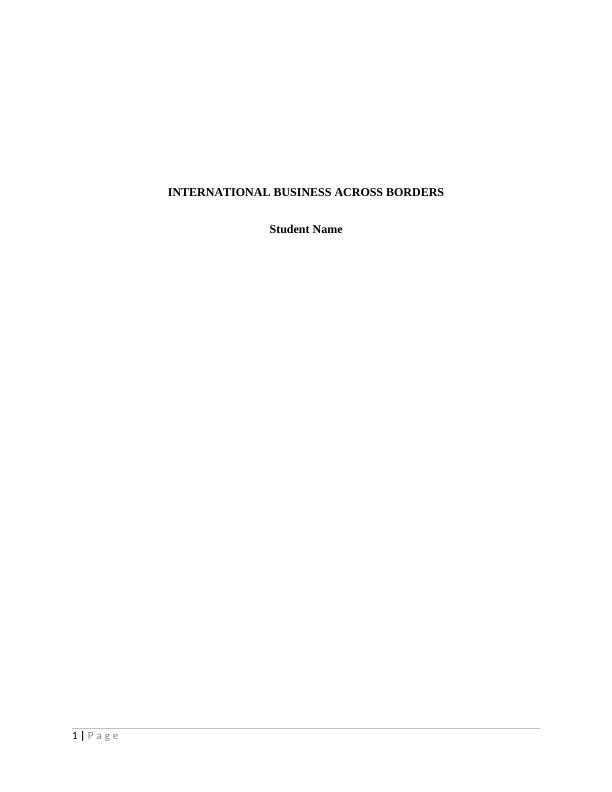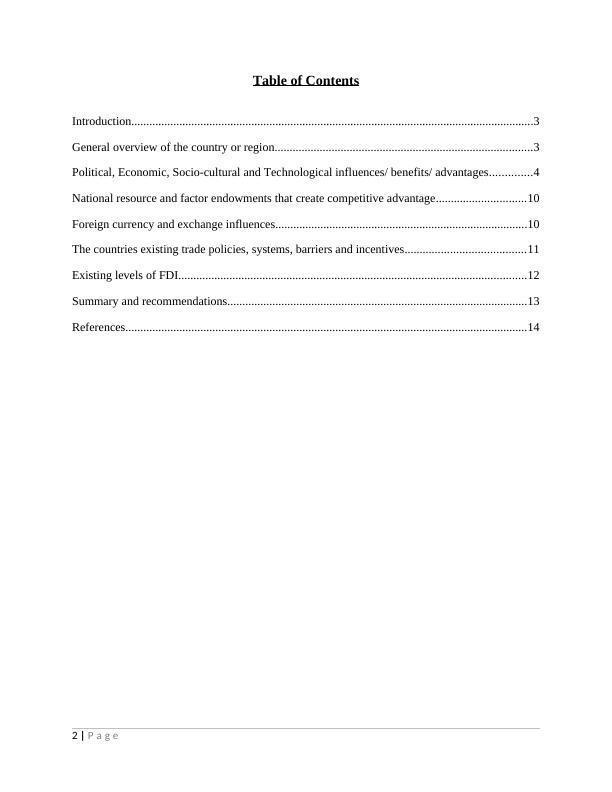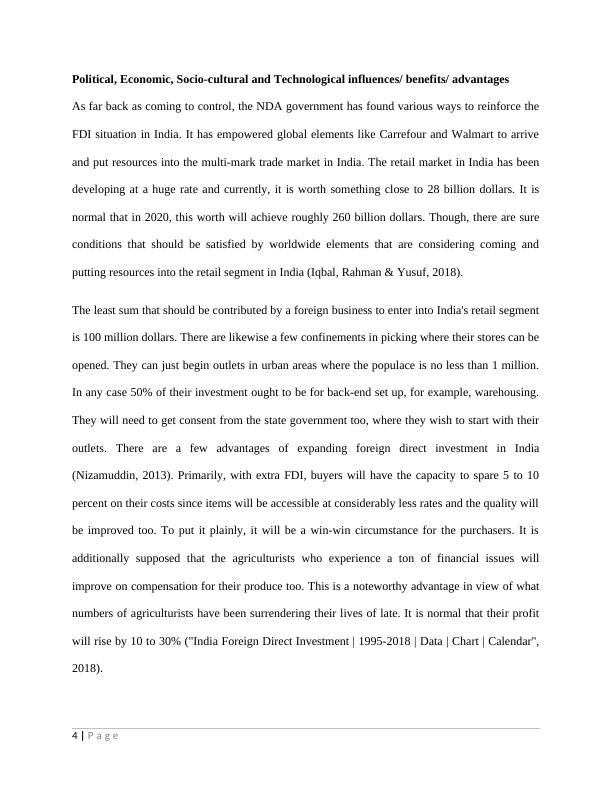Country Analysis and Evaluation of India for Foreign Direct Investment (FDI)
Added on 2023-06-12
16 Pages3727 Words327 Views
INTERNATIONAL BUSINESS ACROSS BORDERS
Student Name
1 | P a g e
Student Name
1 | P a g e

Table of Contents
Introduction......................................................................................................................................3
General overview of the country or region......................................................................................3
Political, Economic, Socio-cultural and Technological influences/ benefits/ advantages..............4
National resource and factor endowments that create competitive advantage..............................10
Foreign currency and exchange influences....................................................................................10
The countries existing trade policies, systems, barriers and incentives........................................11
Existing levels of FDI....................................................................................................................12
Summary and recommendations....................................................................................................13
References......................................................................................................................................14
2 | P a g e
Introduction......................................................................................................................................3
General overview of the country or region......................................................................................3
Political, Economic, Socio-cultural and Technological influences/ benefits/ advantages..............4
National resource and factor endowments that create competitive advantage..............................10
Foreign currency and exchange influences....................................................................................10
The countries existing trade policies, systems, barriers and incentives........................................11
Existing levels of FDI....................................................................................................................12
Summary and recommendations....................................................................................................13
References......................................................................................................................................14
2 | P a g e

Introduction
Global economy viewed large-scale decolonization in the post-war phase, which led to a strong
need for growth amongst the recently independent nations. Actually, the 'Big-Push' theory got
approval in this phase and increased the quantum of investment by bigger enlistment of domestic
resources and exterior support in these nations (Donaldson, Koulovatianos, Li & Mehra, 2016).
There was a widespread conviction that the gains from development would itself drip to the
lowest step of the economic ladder. Though, the development rate stayed extremely low
regardless of massive investment.
The aim of this report is to carry out a country analysis and evaluation of a new emerging market
where quick GDP growth has led to striking investment opportunities. The chosen nation for
study is India with the assessment of its prospects and opportunity for Foreign Direct Investment
(FDI).
General overview of the country or region
India has applied the key strategy of investment from various nations to raise the economy. By
the liberalization of 1991, the path for globalization was laid. Extra practical and scientific plan
and strategies were applied. Later, huge stress was laid on foreign investment (Kumar, 2017).
Diverse constraints like red tapism, license strategy were removed. Following 1991 further
pressure was laid on competition and fair business practices. Slowly and steadily each segment
was opened for foreign investors. Thus, the foreign investors could invest inside India either by
monetary or technological alliances, Joint Ventures, capital markets or by privileged allowances
by including a fully owned subsidiary or corporation.
3 | P a g e
Global economy viewed large-scale decolonization in the post-war phase, which led to a strong
need for growth amongst the recently independent nations. Actually, the 'Big-Push' theory got
approval in this phase and increased the quantum of investment by bigger enlistment of domestic
resources and exterior support in these nations (Donaldson, Koulovatianos, Li & Mehra, 2016).
There was a widespread conviction that the gains from development would itself drip to the
lowest step of the economic ladder. Though, the development rate stayed extremely low
regardless of massive investment.
The aim of this report is to carry out a country analysis and evaluation of a new emerging market
where quick GDP growth has led to striking investment opportunities. The chosen nation for
study is India with the assessment of its prospects and opportunity for Foreign Direct Investment
(FDI).
General overview of the country or region
India has applied the key strategy of investment from various nations to raise the economy. By
the liberalization of 1991, the path for globalization was laid. Extra practical and scientific plan
and strategies were applied. Later, huge stress was laid on foreign investment (Kumar, 2017).
Diverse constraints like red tapism, license strategy were removed. Following 1991 further
pressure was laid on competition and fair business practices. Slowly and steadily each segment
was opened for foreign investors. Thus, the foreign investors could invest inside India either by
monetary or technological alliances, Joint Ventures, capital markets or by privileged allowances
by including a fully owned subsidiary or corporation.
3 | P a g e

Political, Economic, Socio-cultural and Technological influences/ benefits/ advantages
As far back as coming to control, the NDA government has found various ways to reinforce the
FDI situation in India. It has empowered global elements like Carrefour and Walmart to arrive
and put resources into the multi-mark trade market in India. The retail market in India has been
developing at a huge rate and currently, it is worth something close to 28 billion dollars. It is
normal that in 2020, this worth will achieve roughly 260 billion dollars. Though, there are sure
conditions that should be satisfied by worldwide elements that are considering coming and
putting resources into the retail segment in India (Iqbal, Rahman & Yusuf, 2018).
The least sum that should be contributed by a foreign business to enter into India's retail segment
is 100 million dollars. There are likewise a few confinements in picking where their stores can be
opened. They can just begin outlets in urban areas where the populace is no less than 1 million.
In any case 50% of their investment ought to be for back-end set up, for example, warehousing.
They will need to get consent from the state government too, where they wish to start with their
outlets. There are a few advantages of expanding foreign direct investment in India
(Nizamuddin, 2013). Primarily, with extra FDI, buyers will have the capacity to spare 5 to 10
percent on their costs since items will be accessible at considerably less rates and the quality will
be improved too. To put it plainly, it will be a win-win circumstance for the purchasers. It is
additionally supposed that the agriculturists who experience a ton of financial issues will
improve on compensation for their produce too. This is a noteworthy advantage in view of what
numbers of agriculturists have been surrendering their lives of late. It is normal that their profit
will rise by 10 to 30% ("India Foreign Direct Investment | 1995-2018 | Data | Chart | Calendar",
2018).
4 | P a g e
As far back as coming to control, the NDA government has found various ways to reinforce the
FDI situation in India. It has empowered global elements like Carrefour and Walmart to arrive
and put resources into the multi-mark trade market in India. The retail market in India has been
developing at a huge rate and currently, it is worth something close to 28 billion dollars. It is
normal that in 2020, this worth will achieve roughly 260 billion dollars. Though, there are sure
conditions that should be satisfied by worldwide elements that are considering coming and
putting resources into the retail segment in India (Iqbal, Rahman & Yusuf, 2018).
The least sum that should be contributed by a foreign business to enter into India's retail segment
is 100 million dollars. There are likewise a few confinements in picking where their stores can be
opened. They can just begin outlets in urban areas where the populace is no less than 1 million.
In any case 50% of their investment ought to be for back-end set up, for example, warehousing.
They will need to get consent from the state government too, where they wish to start with their
outlets. There are a few advantages of expanding foreign direct investment in India
(Nizamuddin, 2013). Primarily, with extra FDI, buyers will have the capacity to spare 5 to 10
percent on their costs since items will be accessible at considerably less rates and the quality will
be improved too. To put it plainly, it will be a win-win circumstance for the purchasers. It is
additionally supposed that the agriculturists who experience a ton of financial issues will
improve on compensation for their produce too. This is a noteworthy advantage in view of what
numbers of agriculturists have been surrendering their lives of late. It is normal that their profit
will rise by 10 to 30% ("India Foreign Direct Investment | 1995-2018 | Data | Chart | Calendar",
2018).
4 | P a g e

End of preview
Want to access all the pages? Upload your documents or become a member.
Related Documents
Report on Foreign Direct Investment in Indialg...
|13
|2820
|178
The Opportunities and Challenges of Chineselg...
|19
|4158
|10
International Business in Indialg...
|11
|2947
|437
National Resources and Factor Endowment Assignmentlg...
|12
|3102
|356
Feasibility of Foreign Direct Investment in Chinalg...
|14
|3077
|201
International trade Assignment PDFlg...
|15
|843
|77
